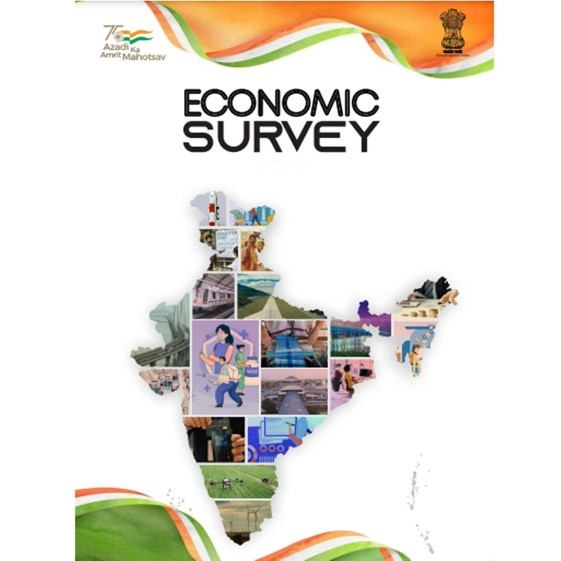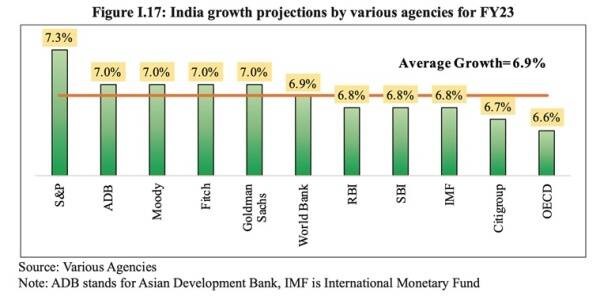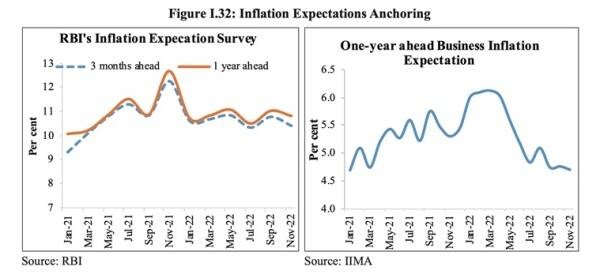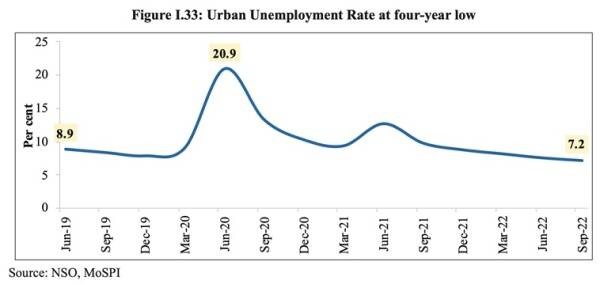Description

Disclaimer: Copyright infringement not intended.
Context:
- Recently, the government tabled the Economic Survey 2022-23. The Survey laid out the outlook for India’s growth, inflation and unemployment in the coming years.
What is the Economic Survey?
- The Survey provides a detailed report of the national economy for the year along with forecasts.
- It touches upon everything from agriculture to unemployment to infrastructure. It is prepared by the Economic Division of the Department of Economic Affairs (DEA).

Note: The comments or policy solutions contained in the Survey are not binding on the government.
What are the main takeaways this year?
GDP Growth
- The Survey said India’s growth estimate for FY23 is higher than for almost all major economies.
- Despite strong global headwinds and tighter domestic monetary policy, if India is still expected to grow between 6.5 and 7.0 per cent, and that too without the advantage of a base effect, it is a reflection of India’s underlying economic resilience; of its ability to recoup, renew and re-energise the growth drivers of the economy.
|
BASE EFFECT
It refers to the impact of an increase in the price level (i.e. previous year’s inflation) over the corresponding rise in price levels in the current year (i.e., current inflation). If the inflation rate was low in the corresponding period of the last year, then even a small increase in the price index will give a high rate of inflation in the current year.
|
.jpeg)
Inflation
- The RBI has projected headline inflation at 6.8% in FY23, outside its comfort zone of 2% to 6%. High inflation is seen as one big factor holding back demand among consumers.
- However, the Survey sounded optimistic about the inflation levels and trajectory, saying “it is not high enough to deter private consumption and also not so low as to weaken the inducement to invest.”

Unemployment
- The Survey said “employment levels have risen in the current financial year”, and that “job creation appears to have moved into a higher orbit with the initial surge in exports, a strong release of the “pent-up” demand, and a swift rollout of the capex.”
- It pointed to the Periodic Labour Force Survey (PLFS), which showed that urban unemployment rate for people aged 15 years and above declined from 9.8% in the quarter ending September 2021 to 7.2% one year later.

- The Survey also underlined that the fall in unemployment rate is accompanied by an improvement in the labour force participation rate.
Outlook for 2023-24
- The Survey projected a baseline GDP growth of 6.5% in real terms in FY24.
- However, it detailed some downside risks. For instance, low demand for Indian exports, (due to poor global growth), may widen India’s trade deficit and make the rupee depreciate. Similarly, sustained monetary tightening (higher interest rates) may drag down economic activity in FY24.
What does it mean for India’s economy?
- The central thrust of this year’s Survey is that India’s economy has recovered from the Covid disruption and, at long last, is poised to see sustained robust growth in the rest of the decade.
- The phase between 2014 and 2022— has witnessed “wide-ranging structural and governance reforms that strengthened the economy’s fundamentals by enhancing its overall efficiency”.
NOTE: These reforms had not yielded the desired results because banks were getting rid of their non-performing assets (NPAs) and business firms were deleveraging. Shocks such as the Covid pandemic and the Ukraine war made matters worse.
Reference to 2003:
- The Survey argued that the situation in 2023 is similar to how the economy was poised in 2003.
- It said the period between 2014 and 2022 is analogous to 1998-2002, when despite transformative reforms by the government the Indian economy lagged growth returns. This was due to temporary shocks such as the US sanctions after India’s nuclear test, two successive droughts, the collapse of the tech boom, etc. But once these shocks faded, the structural reforms paid growth dividends from 2003. The Survey claims the same story is set to repeat from 2023.
Closing Thoughts:
- India is the world’s most populous country with a growing youth bulge. It has the world’s largest pool of poor people and the largest pool of malnourished children.
- Given the low levels of per capita income, it requires much faster growth than many developed countries.
- A growth rate of 4% in India can feel like a recession and even though a 6% growth should be achievable, it may not create enough jobs to satisfy a growing population.

https://indianexpress.com/article/explained/explained-economics/economic-survey-2023-here-are-the-key-takeaways-8415625/



















